The Need for Synthetic EMF Exposure Guidelines
Two questions begin a productive dialogue regarding synthetic EMF exposure in the home. The first question is: Assuming the only known safe level of exposure is zero, how much synthetic EMF do you wish to expose yourself to in your home? The second question is: How much synthetic EMF are you exposed to today in your home?
This week, I received replies from a new friend in the UK of "zero" and "I don't know"—pretty typical responses. How about you? What answers do you give to these critical questions? Where does your home stack up? What opportunities do you have to improve?
To help people take control of synthetic EMF exposures in their homes, we need a set of metrics for comparison. This allows us to characterize our findings and understand the extent of exposure—how good or bad the situation is. We also need to measure remediation efforts to ensure they are successful.
My most sensitive clients need to be certain they can be safe in a specific location, while my precautionary clients need to understand their exposures and measure progress toward lowering personal and familial exposure.
.
Zero as the Only Legitimate Safe Level of Exposure
There's no way I'm waiting for official agencies to dictate the consensus on safe levels of synthetic EMF exposures. Given that key bodies responsible for industry oversight have become captured agencies, the vast majority of industry-sponsored research concludes no effect, andcurrent guidelines ignore non-thermal effects, I advocate for evaluation criteria centered around zero exposure for the following reasons:
Witnessed Improvements: I've seen dramatic turnarounds in vitality for the afflicted, including myself, who pursue the lowest attainable synthetic EMF exposure.
Synthetic EMF is not a part of the creation – it doesn't exist in nature.
Zero measurable exposure is what my most sensitive clients demand.
Following the precautionary principle, the most conservative posture is prudent avoidance until all forms of synthetic EMF exposure are proven harmless.
Other well-respected EMF Consultants center around zero as well.
Supporting evidence for the cumulative effects of "radio wave sickness," or electrohypersensitivity (EHS), includes:
Historical Observations: Early research and observations, such as those documented by the Soviet and Eastern European studies in the mid-20th century, noted that long-term exposure to low-level radio frequency (RF) radiation could lead to various symptoms, including headaches, fatigue, and cognitive issues. These studies suggested that the effects accumulated over time.
Bioinitiative Report: The Bioinitiative Report compiles research from various scientists and health experts, highlighting the long-term biological effects of RF exposure. The report emphasizes that chronic exposure to even low levels of EMF can lead to health problems, suggesting a cumulative impact.
Interphone Study: The Interphone Study, a large international case-control study, found an increased risk of glioma (a type of brain tumor) associated with long-term use of mobile phones, implying cumulative effects of RF exposure over time.
Animal Studies: Research on animals, such as the National Toxicology Program (NTP) study, has shown that prolonged exposure to RF radiation can lead to increased cancer risks and other health issues, providing evidence of cumulative biological effects.
Epidemiological Studies: Several epidemiological studies have reported associations between long-term RF exposure and various health issues, including increased risks of certain cancers, neurological disorders, and reproductive issues. These findings support the notion that the effects of RF exposure can build up over time.
Mechanistic Studies: Research on the mechanisms of EMF interaction with biological tissues has shown that prolonged exposure can lead to oxidative stress, DNA damage, and disruption of cellular processes. These effects can accumulate and contribute to long-term health problems.
Arthur Firstenberg, in his book "The Invisible Rainbow," argues that what harms the most sensitive individuals in a population can eventually harm everyone. He emphasizes that while some people might exhibit immediate and severe reactions to electromagnetic fields (EMFs), these exposures can have cumulative effects on the broader population over time, potentially leading to various health issues.
There is much support for RF radiation harm; it's the 800-pound gorilla in the room, but I extend my rationale for zero as the only known safe level of exposure to include AC electric fields, AC magnetic fields and dirty electricity because:
The diseases of modern civilization followed the rollout of the electric power grid in North America (Firstenberg, Milham).
These fields do not exist in nature.
They have never been proven to be without harm.
Although there is no good control group across demographic factors, the Amish community's better health outcomes, compared to the general American population through the 1980s, do not conclusively prove but lend support to the idea that avoiding AC electric fields, AC magnetic fields, and dirty electricity may be beneficial.
All this being said, zero is problematic even with no electric power.
The Concept of Zero in Synthetic EMF Exposure is Relative
Without getting into too much detail, zero isn't always zero. For example, the concept of zero can be misleading when discussing exposure to RF radiation. A reading of 0 μW/m² is not the same as 0.0, 0.00, or 0.000. Each additional decimal place represents a higher degree of precision and indicates significant digits that provide more accurate measurements. Even minute levels of RF radiation can have biological effects. Therefore, what might appear as 'zero' exposure on a less precise instrument could still indicate low radiation levels.
For example, an RF exposure that reads 0.000μW/m² on a meter with a sensitivity of 0.001µW/m² may actually represent a field strength up to 0.00049 µW/m² depending on the design of the meter. This illustrates how the perceived zero is actually a small but potentially significant level of exposure.
Zero is always relative to the accuracy and sensitivity of the measurement device, the interval in time the measurement is taken, the duration of a peak event relative to the device's sample rate, and the area over which the measurement is taken. Even with the finest meters available, there may always be a residual, immeasurable portion that could still have a biological impact. Thus, achieving true zero exposure may be illusory, especially in the era of RF bombardment from space.
The Basic Four Exposures
As you may have noticed, proper EMF assessment and remediation is a fiddly process—filled with complexity and nuance. I wish it weren't so, but it is. For now, we will discuss the primary four synthetic EMF exposures I find in every home. To be sure, there are other considerations, and God willing, we'll get to those in good time, but these four are a good start.
AC magnetic fields (MF) easily penetrate common building materials and are generated by alternating current (AC) flow through electrical wiring, power lines approaching your home, and appliances within the home. These fields are of greatest intensity near devices that use a lot of electricity, such as refrigerators, air conditioners, and washing machines. In certain situations, MF relates to errors in household wiring. Unfortunately, in North America, some of the MF exposure in your home is caused by the electrical grid design, which allows current to flow through the earth.
AC electric fields (EF) are created by the voltage present in above-ground power lines, electrical wiring within the home, and appliances, even when they are not in use. These fields are proportional in intensity to voltage, not current, and are omnipresent in homes with unshielded wiring, emanating from walls, ceilings, floors, power cords, and nearby overhead power lines.
Radio-frequency (RF) radiation is intentionally emitted by wireless devices such as smart meters, cell phones, Wi-Fi routers, baby monitors, Bluetooth equipment, and more. These high-frequency fields are pervasive in modern environments and can easily pass through walls and other obstacles. Significant sources of RF radiation also include external sources such as cell towers, broadcast antennas, radar systems, and more, which can contribute to the overall RF exposure within a home. RF emitting features from neighbors may also affect RF intensity in your home.
Dirty electricity refers to high-frequency voltage transients and harmonics contaminating homes' 50/60 Hz electrical current. Modern electronic devices and appliances manipulating electricity, such as dimmer switches, computers, solar power systems, and appliances using variable frequency drives, are primary offenders. This type of electrical pollution is pervasive and found throughout homes' electrical systems. As with RF, poor decisions made by others nearby about electrical devices and systems can also affect the levels of dirty electricity in your home.
Can we Get to Zero, in an Ordinary Home?
On the one hand, you may quickly achieve zero using poor quality, inaccurate assessment equipment. In other words, if your equipment is inaccurate over the frequency range of interest, lacks the appropriate sensitivity, or isn't genuinely evaluating the phenomenon under study, you can reach a false zero. However, if you want to achieve zero exposure levels according to equipment appropriate to the task, it may or may not be possible, given several factors.
Approaching zero exposure levels in all four phenomena—EF, EMF, RF, and DE—will involve sacrifice and inconvenience, doesn't come cheap and may be impossible, even with the best remediation techniques. No shielding is perfect, and much depends on the design of the home and the ambient exposure levels.
Counterargument -- Should We Try to Get to Zero?
My work as an Independent EMF Consultant revolves around helping people find or create environments with the lowest possible synthetic EMF exposures and aiding those who wish to take a precautionary approach in lowering their current exposures. But is this the right thing to do, and if so, why?
Arthur Firstenberg recently wrote a well-referenced and compelling article titled Power level is irrelevant and subtitled Radio waves are harmful, period!
Here's a quote from Mr Firstenberg's article:
Allan Frey wrote:
"Electromagnetic fields are not a foreign substance to living beings like lead or cyanide. With foreign substances, the greater the dose, the greater the effect -- a dose-response relationship. Rather, living beings are electrochemical systems that use very low frequency EMFs in everything from protein folding through cellular communication to nervous system function. To model how EMFs affect living beings, one might compare them to the radio we use to listen to music.
"The EMF signal the radio detects and transduces into the sound of music is almost unmeasurably weak. At the same time, there are, in toto, strong EMFs impinging on the radio. We don't notice the stronger EMF signals because they are not the appropriate frequency or modulation. Thus, they don't disturb the music we hear. However, if you impose on the radio an appropriately tuned EMF or harmonic, even if it is very weak, it will interfere with the music. Similarly, if you impose a very weak EMF signal on a living being, it has the possibility of interfering with normal function if it is properly tuned. That is the model that much biological data and theory tell us to use, not a toxicological model." This is the source he references: Allan H. Frey. Is a toxicology model appropriate as a guide for biological research with electromagnetic fields? Journal of Bioelectricity 9(2):233-234 (1990).
How little intensity may cause harm?
Here's the thing: no portable synthetic EMF assessment tools have the sensitivity and accuracy to quickly measure such small intensities of RF radiation over a useful portion of the spectrum during home assessment. The most appropriate meter I have for the above examples, with the required accuracy and frequency range, has a sensitivity of 0.001 μW/m2. This means I can't accurately measure the power densities shown to be associated with the effects listed above.
Also, based on my experience, I don't believe achieving thresholds lower than those listed in the table above is possible – certainly not in or near a metropolitan area.
The article by Mr. Firstenberg and the very low levels of exposure that cause physiological effects teach us that passing data through the air is harmful. It's not sustainable in the true meaning of the word. We're risking life on earth by indulging our tech addictions based on wireless radiation.
With all this in mind, I sleep well at night, knowing I've helped many people, including myself, by working toward zero exposure for those who need it and helping others make reductions even when approaching zero isn’t feasible.
It wasn't until I constructed a synthetic EMF-resistant home and began living there that my 3+ decades of misdiagnosed "anxiety disorder" vanished entirely. So did my sympathetic nervous system overdrive, insomnia, cardiac dysrhythmia, cognitive impairment (brain-fog), and chronic fatigue. I'm increasing resilience to synthetic EMF exposure and experiencing decreased sensitivity with each passing day. After years of not being able, I could work at a job, attend church again, and take my wife out to lunch without suffering.
Others most seriously harmed by synthetic EMF who have taken the implications of electrical sensitivity seriously live productive and fulfilling lives in greater peace by achieving lower exposures today. When asked, they, like me, would not go back—knowing the harm of greater intensity of exposure, we would not willingly return to our previous lives filled with synthetic EMF exposure. Not many are willing to speak on camera about their transformation, but here,here, here,here here and here are some conversations of note.
Why is this so? Why does lowering exposure objectively benefit people? I honestly don't know, but perhaps it's like this: getting out of the 'burn' to a lower threshold, unique to each individual, allows us to recover more quickly than ongoing exposures are damaging us. I'll leave all that to honest scientists and doctors to figure out one day. That is, if they're allowed, if they're funded, if it doesn’t go against the official narrative, and if their results are made public.
In the meantime, I get my best results assessing people's homes according to specific exposure levels and across all types of EMF phenomena, helping them achieve their desired levels of exposure, and they seem to be happy.
Grading on a Curve
Since approaching zero is quite complex, perhaps we should lower the bar—grade on a curve, if you will. This thought led to the idea of precautionary guidelines, including ranges of exposures. I'm of two minds on this topic. On the one hand, I've personally experienced and seen through others the superiority of approaching zero; on the other, I realize not everyone is willing to do what's needed to accomplish this. Pass/fail grading can be demoralizing and unproductive.
What is our justification for arguing that lower exposure ranges are better than higher exposure ranges?
The bottom line for me is that when working with exquisitely sensitive clients, they do better, recover faster, or generally improve in areas of lower intensity exposure compared to higher. These are other key points:
Reduced Health Risks: Lower exposure ranges are generally associated with a reduced risk of potential health issues.
Minimized Cumulative Effects: Even if zero exposure isn't achievable, reducing exposure as much as possible can minimize the cumulative effects of synthetic EMFs linked to various health problems.
Precautionary Principle: Adopting lower exposure levels aligns with the precautionary principle, advocating for the least exposure in the face of uncertainty.
Incremental Improvements: This approach allows incremental improvements and encourages people to make feasible changes.
Assessment Guidelines
Organizations that promote precautionary measures with regard to synthetic EMF exposure include:
Building Biology Institute
BioInitiative Report: An international group of scientists, researchers, and public health policy professionals that review the scientific evidence on EMF exposure and advocate for lower exposure limits.
European Academy for Environmental Medicine (EUROPAEM): Publishes guidelines and research on the health impacts of EMF exposure and promotes preventive measures.
EMF Scientists Appeal: A coalition of scientists calling for stronger regulatory standards to protect public health from EMF exposure.
The evaluation criteria I use for EMF Remedy clients are similar to those promoted by the Building Biology Institute (BBI). The significant departure in my guidelines is for dirty electricity exposure (DE). I've come to believe the Stetzerizer® Microsurge Meter is the better DE survey instrument due to its weighting of higher frequencies, the appropriate ranges are those listed on that device, and the stand-alone oscilloscope is the best tool for verification during remediation.
Now that you know why I use them, here at last are the guidelines I use:
AC Magnetic Field Exposures
AC Electric Field Exposures
Radio-frequency Radiation Exposures
Dirty Electricity Exposures
Conclusion
In our introduction, we shared two questions that begin a productive dialogue: Assuming the only known safe level of exposure is zero, how much synthetic EMF do you wish to expose yourself to in your home? The second question is: How much synthetic EMF are you exposed to today in your home?" A set of exposure guidelines unlocks our ability to answer these questions.
Exposure guidelines, closer to biological reality than official guidelines, direct our work, helping us focus on the electromagnetic envelope, not just one phenomenon. The numbers used by the Building Biology folks are a basis I support, subject to the comments on DE I mentioned.
We use metrics that begin at zero, even knowing that zero exposure to an appreciable number of significant digits is likely no longer possible on earth nor measurable with available assessment tools.
Exposure guidelines help people take control of synthetic EMF exposures in their homes and identify the superiority of one home versus another. We specify various ranges so that people who cannot achieve levels close to zero still have meaningful goals to strive for. These criteria are essential for assessing land and homes, determining suitability for habitation, planning remediation, and making comparisons.
For sensitive clients, these evaluation criteria provide confidence in recognizing the healing potential of improved living environments through objective measures that consider all four phenomena.



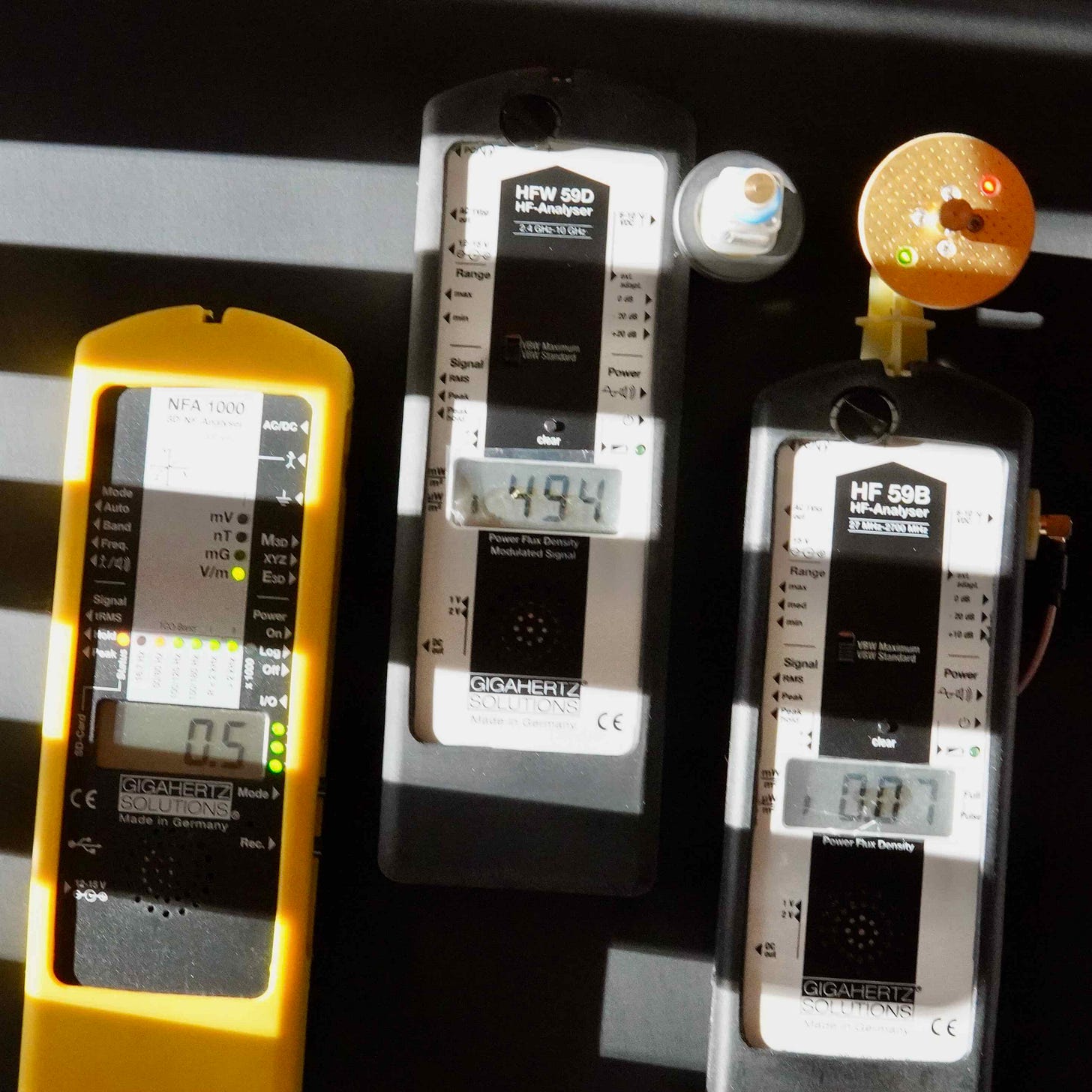
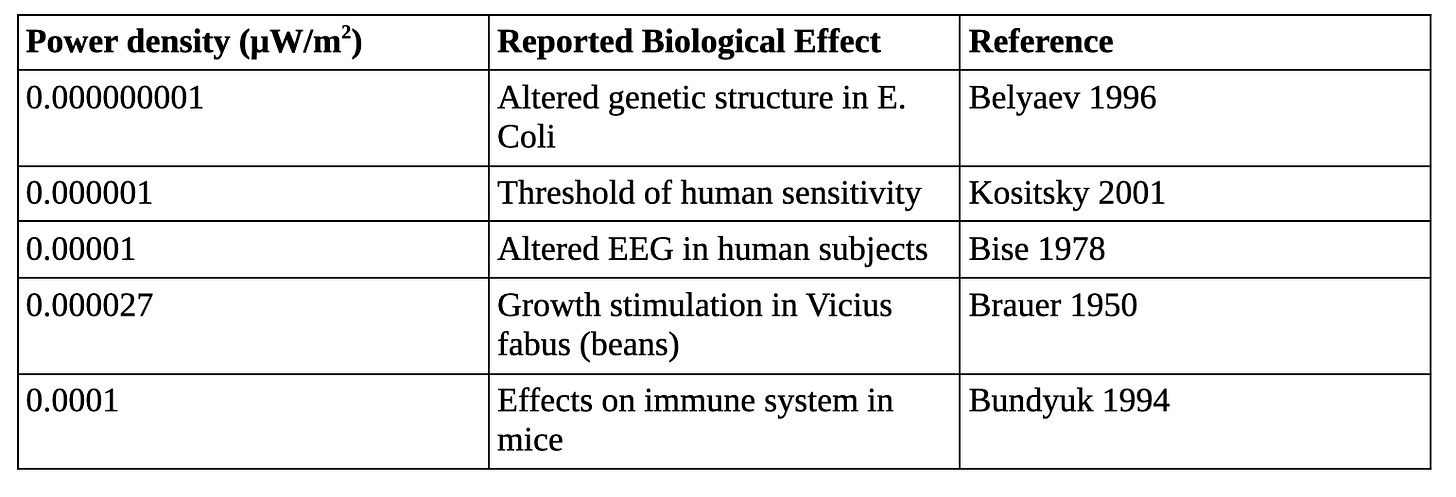
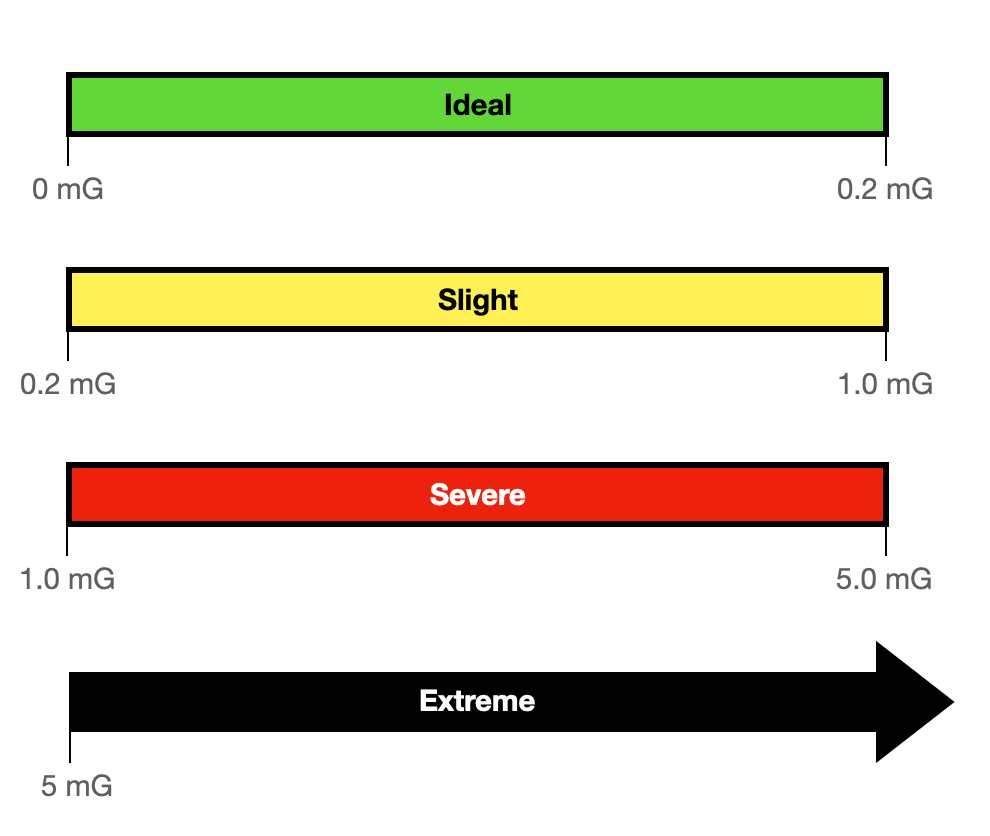
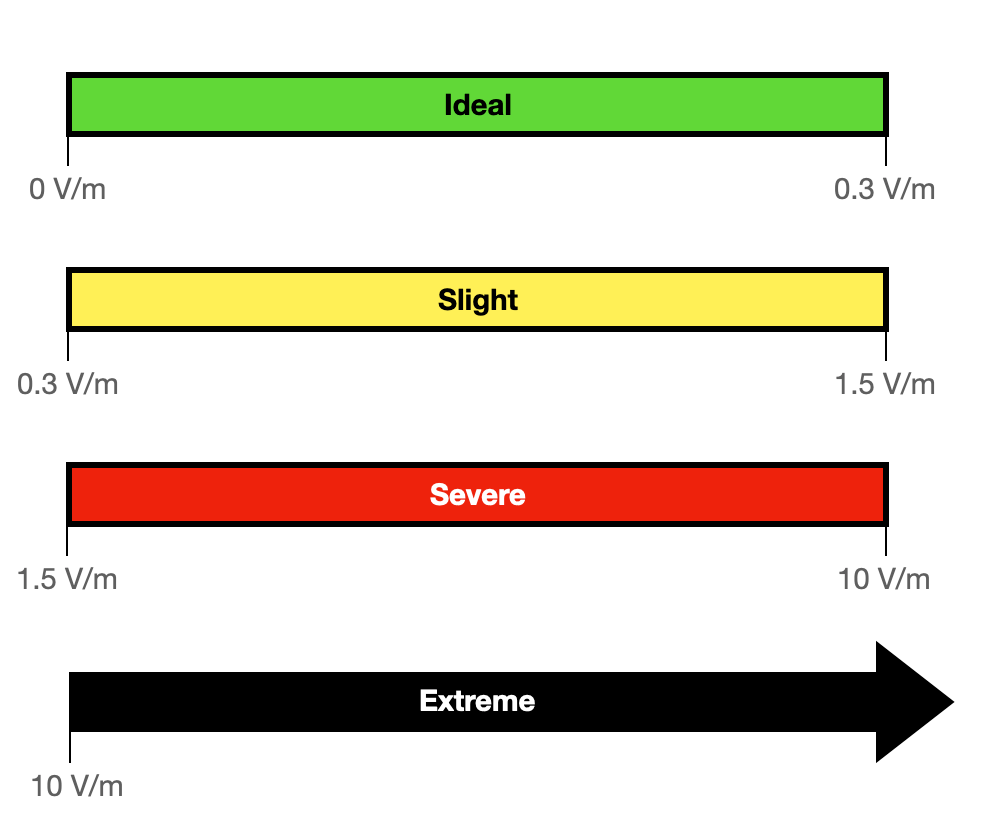
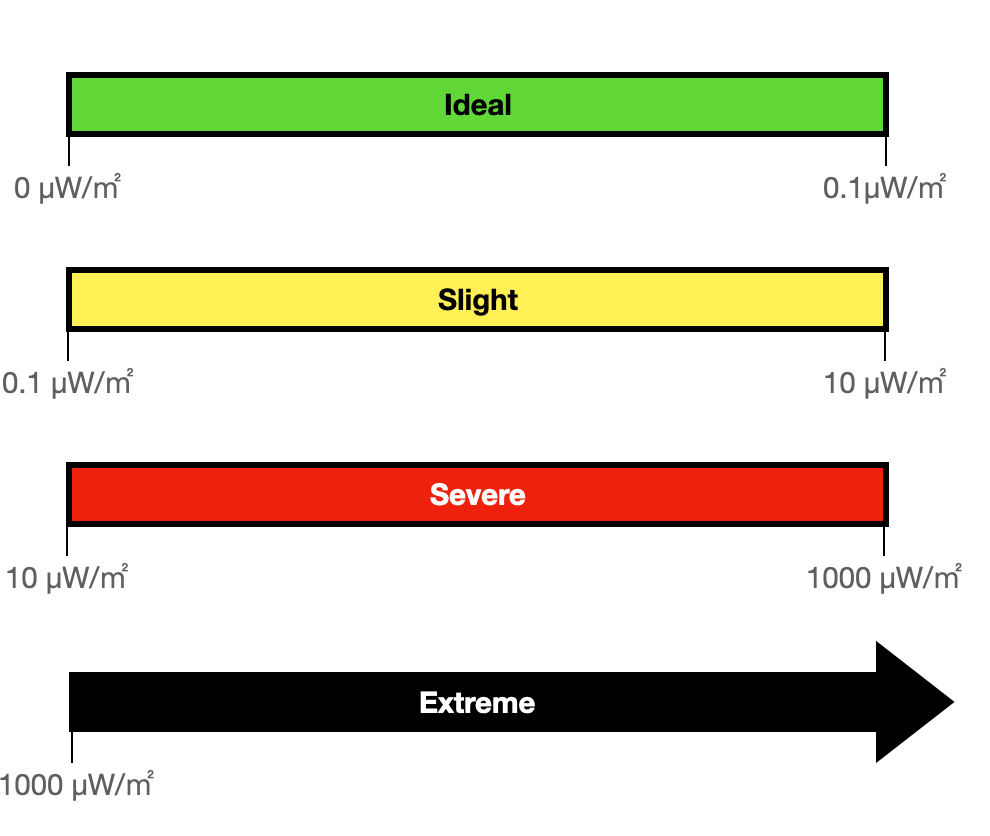
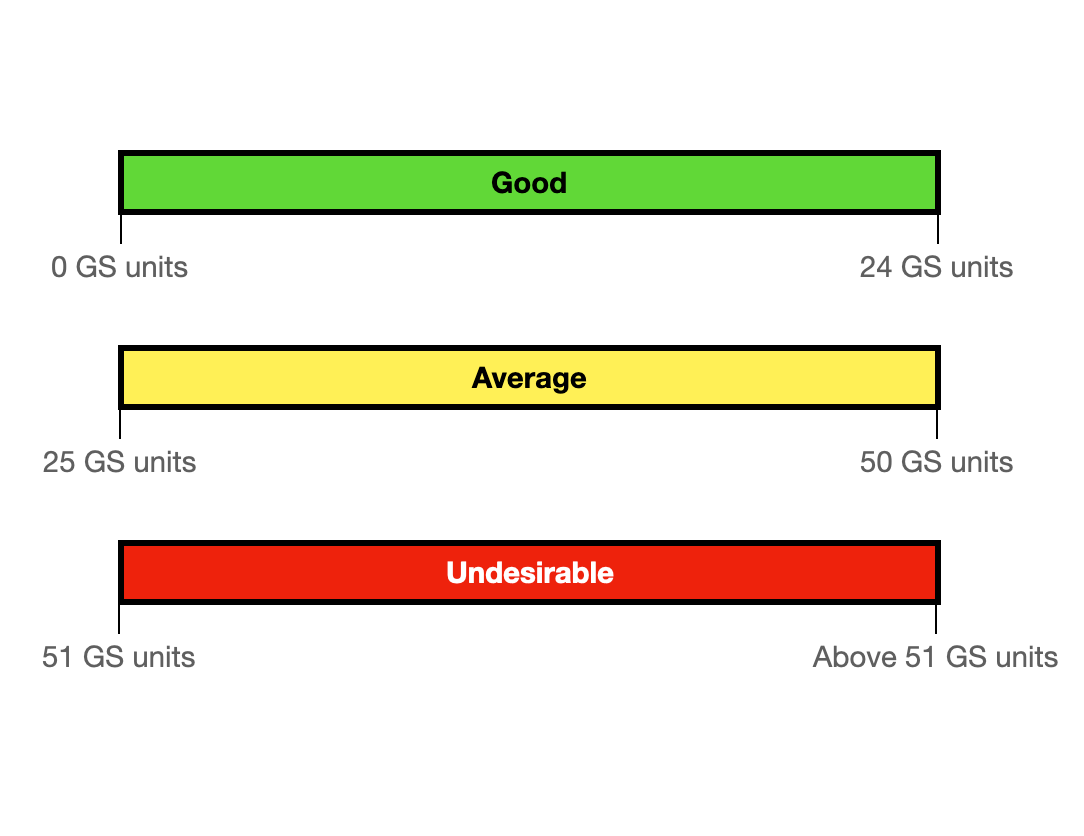
Thanks Keith, these two questions, taken together, open up a wide field of thought.
If we transpose this to other poisons: “What dose of cyanide do you find acceptable to ingest on a daily basis?”, or “What dose of nuclear radiation do you find acceptable to be permanently exposed to?”, “How many cigarettes can a child smoke per month?”, the answer will probably be unanimously “Zero!
I hope I'll still be around when the unanimous answer is “zero!” when it comes to synthetic EMFs. The only way we'll ever get there is if we keep believing it's possible.
Comments on the topics discussed in this article are welcome; other comments off-topic may be removed for the sake of focus. We're building a foundation upon which we can all benefit, creating healthier exposures in our homes.